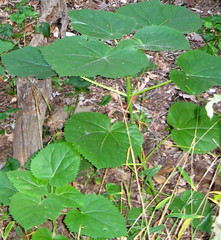Climate and Weather
Learn More
Other Websites
Climate and weather are natural processes that help shape natural communities. However, severe natural disturbances and climate change may potentially have far-reaching impacts on natural communities of Rock Creek Park.
Explore this page:
Expected Climate Trends
Climate patterns in the Mid-Atlantic region where Rock Creek Park is located have been consistent for the past few thousand years—but these patterns are now beginning to change.
According to reports from the Climate Preparedness Program of the Metropolitan Washington Council of Governments, the following recently observed trends in the National Capital Region are expected to continue.
 Rock Creek at flood stage.
Rock Creek at flood stage.
Photographer: Ryan Valdez.Temperature
- Higher average temperatures
- More frequent heat waves
- More days over 90 degrees F
- Fewer freezing days
- Warmer nights relative to days
Precipitation, Storms, and Sea Level
- Precipitation concentrated into fewer events
- Increased precipitation variability
- Possible increased frequency of drought
- Increase in intensity of coastal storms, such as hurricanes and nor’easters
- Sea level rise combined with local land subsidence and storm surges.
Possible Impacts on Rock Creek Park’s Natural Communities
Individual species thrive in specific climatic conditions. Interactions among species often depend on climatic conditions as well. For these reasons, there are as many possible impacts of climate change as there are species and species interactions in Rock Creek Park. Here are just a few possible impacts:
- Warmer temperatures could lead to the extirpation (local extinction) of some animals and plants for which Rock Creek Park is already the southern end of their range.
- Warmer temperatures could also make the climate more hospitable to non-native invasive species of plants, vertebrate animals, invertebrates including insects, and microbial pathogens such as bacteria, viruses, and fungi.
- Warmer nights and fewer freezing days could interfere with the natural signals and requirements of many plants and animals, affecting everything from fruit-setting abilities to overwintering of insects.
- A change to fewer precipitation events could prove difficult for some plants. A species that needs relatively frequent rains might not survive the dry stretches between rainy days—even if the total annual precipitation remained unchanged.
- Heavy precipitation events already pose many challenges to Rock Creek Park as a result of its urban location. An increase in heavy precipitation events would bring more of those same challenges. For more information on stormwater runoff, see Current Water and Land Use.
- In addition to affecting individual species, climate changes could throw off the interactions among species. For example, certain plant species bloom just when migrating hummingbirds arrive. The plants depend on hummingbirds for pollination and the hummingbirds depend on the plants for food. If the plants bloom before hummingbirds arrive, both plants and birds could suffer.
- Many microbes and invertebrate animals that live in the soil play important roles in natural communities. These creatures depend on a certain amount of soil moisture—different creatures live in dry soil, mesic soil, and wet soil. Even if a plant species could survive the change in precipitation patterns, it could be threatened if a beneficial insect or microbe it depends on could no longer survive in those conditions.
Severe Natural Disturbances
Severe natural disturbances such as hurricanes are natural, but they pose challenges to Rock Creek Park, which is a relatively small natural area surrounded by urbanization.
It is more difficult to restore the complex web of interacting species in the forest canopy and soils after a severe disturbance without access to a large nearby source of plants, animals, and seeds.1
The Compounding Problem of Non-Native Invasive Plants
 New sunlit openings in forests are an open invitation for the seeds of non-native invasive plants such as princess-tree (Paulownia tomentosa).
New sunlit openings in forests are an open invitation for the seeds of non-native invasive plants such as princess-tree (Paulownia tomentosa).
Photographer: Erin Lunsford Jones, courtesy of NatureServeEven disturbances that a natural area the size of Rock Creek Park should be able to recover from completely, such as ice storms that fell trees and produce unremarkable canopy gaps, create new challenges today because of the abundance of non-native invasive plant species ready to populate the new openings. (See Non-Native Invasive Plants of Rock Creek Park.)
Although severe natural disturbances are natural, and can be expected to occur from time to time, they may become more frequent with new climate trends.


